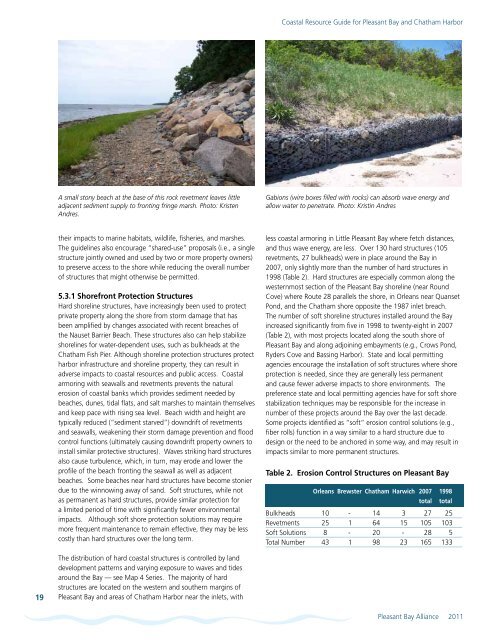Coastal Resource Guide Pleasant Bay and Chatham Harbor
Coastal Resource Guide Pleasant Bay and ... - Town to Chatham
Coastal Resource Guide Pleasant Bay and ... - Town to Chatham
You also want an ePaper? Increase the reach of your titles
YUMPU automatically turns print PDFs into web optimized ePapers that Google loves.
<strong>Coastal</strong> <strong>Resource</strong> <strong>Guide</strong> for <strong>Pleasant</strong> <strong>Bay</strong> <strong>and</strong> <strong>Chatham</strong> <strong>Harbor</strong><br />
A small stony beach at the base of this rock revetment leaves little<br />
adjacent sediment supply to fronting fringe marsh. Photo: Kristen<br />
Andres.<br />
Gabions (wire boxes filled with rocks) can absorb wave energy <strong>and</strong><br />
allow water to penetrate. Photo: Kristin Andres<br />
their impacts to marine habitats, wildlife, fisheries, <strong>and</strong> marshes.<br />
The guidelines also encourage “shared-use” proposals (i.e., a single<br />
structure jointly owned <strong>and</strong> used by two or more property owners)<br />
to preserve access to the shore while reducing the overall number<br />
of structures that might otherwise be permitted.<br />
5.3.1 Shorefront Protection Structures<br />
Hard shoreline structures, have increasingly been used to protect<br />
private property along the shore from storm damage that has<br />
been amplified by changes associated with recent breaches of<br />
the Nauset Barrier Beach. These structures also can help stabilize<br />
shorelines for water-dependent uses, such as bulkheads at the<br />
<strong>Chatham</strong> Fish Pier. Although shoreline protection structures protect<br />
harbor infrastructure <strong>and</strong> shoreline property, they can result in<br />
adverse impacts to coastal resources <strong>and</strong> public access. <strong>Coastal</strong><br />
armoring with seawalls <strong>and</strong> revetments prevents the natural<br />
erosion of coastal banks which provides sediment needed by<br />
beaches, dunes, tidal flats, <strong>and</strong> salt marshes to maintain themselves<br />
<strong>and</strong> keep pace with rising sea level. Beach width <strong>and</strong> height are<br />
typically reduced (“sediment starved”) downdrift of revetments<br />
<strong>and</strong> seawalls, weakening their storm damage prevention <strong>and</strong> flood<br />
control functions (ultimately causing downdrift property owners to<br />
install similar protective structures). Waves striking hard structures<br />
also cause turbulence, which, in turn, may erode <strong>and</strong> lower the<br />
profile of the beach fronting the seawall as well as adjacent<br />
beaches. Some beaches near hard structures have become stonier<br />
due to the winnowing away of s<strong>and</strong>. Soft structures, while not<br />
as permanent as hard structures, provide similar protection for<br />
a limited period of time with significantly fewer environmental<br />
impacts. Although soft shore protection solutions may require<br />
more frequent maintenance to remain effective, they may be less<br />
costly than hard structures over the long term.<br />
less coastal armoring in Little <strong>Pleasant</strong> <strong>Bay</strong> where fetch distances,<br />
<strong>and</strong> thus wave energy, are less. Over 130 hard structures (105<br />
revetments, 27 bulkheads) were in place around the <strong>Bay</strong> in<br />
2007, only slightly more than the number of hard structures in<br />
1998 (Table 2). Hard structures are especially common along the<br />
westernmost section of the <strong>Pleasant</strong> <strong>Bay</strong> shoreline (near Round<br />
Cove) where Route 28 parallels the shore, in Orleans near Quanset<br />
Pond, <strong>and</strong> the <strong>Chatham</strong> shore opposite the 1987 inlet breach.<br />
The number of soft shoreline structures installed around the <strong>Bay</strong><br />
increased significantly from five in 1998 to twenty-eight in 2007<br />
(Table 2), with most projects located along the south shore of<br />
<strong>Pleasant</strong> <strong>Bay</strong> <strong>and</strong> along adjoining embayments (e.g., Crows Pond,<br />
Ryders Cove <strong>and</strong> Bassing <strong>Harbor</strong>). State <strong>and</strong> local permitting<br />
agencies encourage the installation of soft structures where shore<br />
protection is needed, since they are generally less permanent<br />
<strong>and</strong> cause fewer adverse impacts to shore environments. The<br />
preference state <strong>and</strong> local permitting agencies have for soft shore<br />
stabilization techniques may be responsible for the increase in<br />
number of these projects around the <strong>Bay</strong> over the last decade.<br />
Some projects identified as “soft” erosion control solutions (e.g.,<br />
fiber rolls) function in a way similar to a hard structure due to<br />
design or the need to be anchored in some way, <strong>and</strong> may result in<br />
impacts similar to more permanent structures.<br />
Table 2. Erosion Control Structures on <strong>Pleasant</strong> <strong>Bay</strong><br />
Orleans Brewster <strong>Chatham</strong> Harwich 2007 1998<br />
total total<br />
Bulkheads 10 - 14 3 27 25<br />
Revetments 25 1 64 15 105 103<br />
Soft Solutions 8 - 20 - 28 5<br />
Total Number 43 1 98 23 165 133<br />
19<br />
The distribution of hard coastal structures is controlled by l<strong>and</strong><br />
development patterns <strong>and</strong> varying exposure to waves <strong>and</strong> tides<br />
around the <strong>Bay</strong> — see Map 4 Series. The majority of hard<br />
structures are located on the western <strong>and</strong> southern margins of<br />
<strong>Pleasant</strong> <strong>Bay</strong> <strong>and</strong> areas of <strong>Chatham</strong> <strong>Harbor</strong> near the inlets, with<br />
<strong>Pleasant</strong> <strong>Bay</strong> Alliance 2011
















